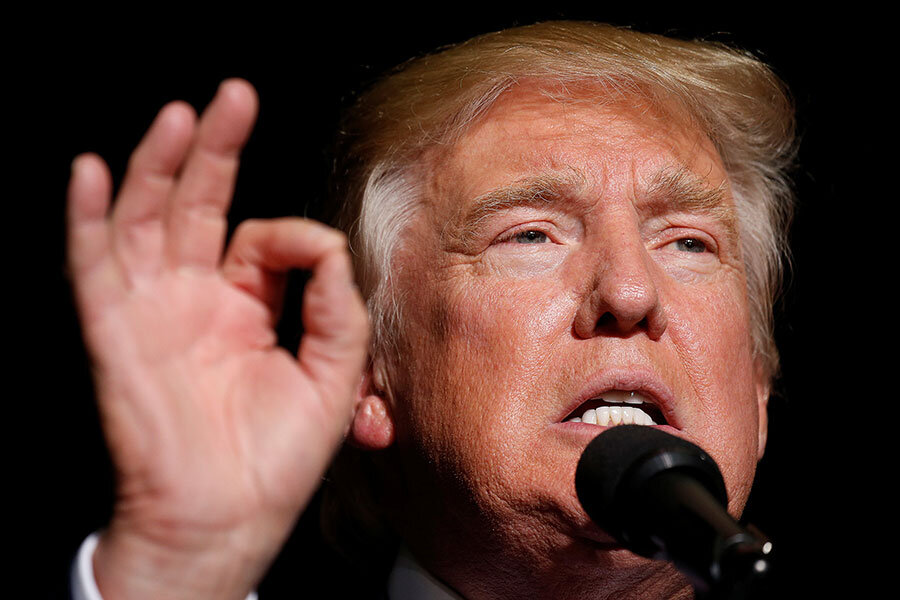Trump calls black neighborhoods 'ghettos' – why the term rankles
Loading...
Donald Trump referred to inner city communities as "ghettos" during a campaign rally in Toledo, Ohio, Thursday.
The Republican presidential nominee has already been criticized for insensitive language relating to the African-American population, and Thursday’s attempt to appeal to black voters seemed to fall on deaf ears. His statements touched on issues that are likely relevant to African-American communities, but his broadcloth painting of black neighborhoods as "ghettos" with "horrible horrible problems" is a nonstarter for many in African-Americans.
Mr. Trump expanded on his previous message during the rally:
We’re going to work on our ghettos. You take a look at what’s going on where you have pockets, areas, of land where you have the inner cities, where you have so many things, so many problems, so many horrible, horrible problems. The violence. The death. The lack of education. No jobs. We’re going to work with the African-American community and we’re going to solve the problem of the inner city. We’re going to bring safety back. You can’t walk out the street, you buy a loaf of bread and you end up getting shot. So we’re going to work very strongly with the African-American community.
And while some see Trump’s terminology as offensive, other political commentators say this kind of rhetoric won’t drastically harm his campaign as he already has dismal polling among African-American voters.
According to poll aggregator Real Clear Politics, Trump’s African-American support nationwide hovers at 7.1 percent compared to Hillary Clinton’s 82.8 percent. A new poll from the Siena College Research Institute and The New York Times shows bleak support for Trump among African-Americans in Pennsylvania, a state where Trump hopes to do well. However, 90 percent of black voters support Clinton and only 1 percent responded with support for Trump.
Still, his choice of language – especially the term ghetto – strikes a particular nerve for not just African-Americans, but for members of the Jewish community as well.
Etymologists say the word was originally used in cities such as Venice, Italy; Frankfurt; and Prague, Czech Republic in the 16th and 17th centuries to refer to quarters where the city’s Jewish population was forcibly segregated. And then in the early 20th century "ghetto" began to signal race and poverty as well as anti-Semitism.
"As early as 1908, 'ghetto' was sometimes used metaphorically to describe slum areas that weren’t mandated by law but that were limited to a single group of people because of other constraints," explains NPR's column Code Switch. Economic and cultural differences, as well as racial prejudice, began to explicitly separate white and nonwhite residents, siloing nonwhite residents to a perceived "ghetto."
Given the word's history, some scholars and political analysts find the term "ghetto" particularly offensive.
"The problem with the word is that it's very difficult to disassociate it from its use to characterise low-income African Americans," Mario Small, a professor of sociology at Harvard University, told the BBC in January after director Quentin Tarnantino came under fire for using the term. "Thus, when ‘ghetto’ is used as an insult, it often sounds like a racial insult."
And it is insulting because it disregards "complexity and dimension" among the community's members, the Atlantic’s Ta-Nehisi Coates wrote in 2009.
"Ghetto, in its most unironic usage, is a word for people you don’t know. It’s a word that allows you to erase individuals and create boxes."
Trump’s comments in Ohio Thursday come after previous comments on America’s inner-cities that its residents found offense.
During the first presidential debate in late September, the Republican nominee said that "African-Americans and Hispanics are living in hell." He later said at a rally in North Carolina that these communities "are absolutely in the worst shape they’ve ever been in before. Ever. Ever. Ever."
The Monitor’s Harry Bruinius spoke with community leaders in Brooklyn’s Bedford-Stuyvesant after Trump made related comments in the first debate. And while national statistics do suggest black Americans are struggling more than white Americans, this particular African-American community disagreed with the Republican nominee’s generalizations.
Brenda Fryson, a member of the Brownstoners of Bedford Stuyvesant, a nonprofit volunteer organization dedicated to the preservation and revitalization of the neighborhood, says the community here, with numerous block associations and a spirited community board, has always been particularly close-knit, even when times were rougher…. "I’m a Brooklyn girl, born and bred," she says with an easy laugh, which occurs often in her conversations. "And what has always impressed me, was that there was this deep commitment to neighbors and community…. That still exists. And I don’t think that’s going anywhere. I think that’s so deep in our DNA that, you know, when people come, we’ve always been a welcoming community, at least that’s been my experience."








